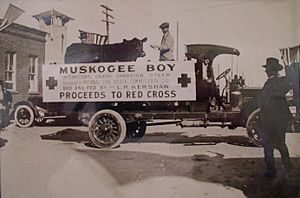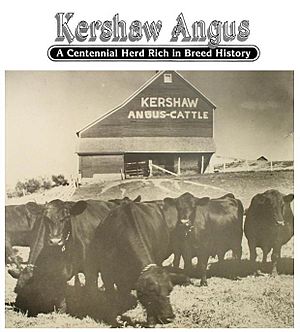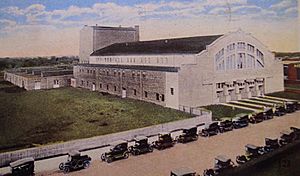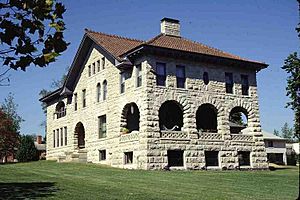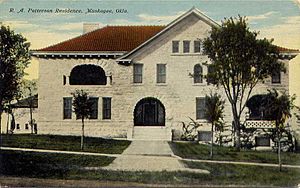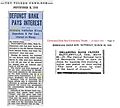L. R. Kershaw facts for kids
Leroy Kershaw (1880–1969) was an American lawyer, banker, and businessman. He was also a successful cattleman and even ran for political office.
Kershaw was one of the first important people in the Muskogee, Oklahoma, area. He even founded the town of Morris, Oklahoma, in 1904. He was a delegate for the Republican Party in 1924. Later, he ran for Governor of Oklahoma in 1930.
Leroy Kershaw was famous for raising purebred Angus cattle. He had over 500 of these special cows. His prize-winning herd of black Angus cattle was very popular. Buyers from all over the country came to his 4,000-acre farm near Muskogee. His herd was the second largest in the entire country. It was also the biggest herd in Oklahoma.
Kershaw's amazing career started in real estate. After college, he sold land. He then got into banking, managing farms, and developing oil and gas. He also built homes and served in politics.
Contents
Early Life and Beginnings
L.R. Kershaw, also known as Leroy Kershaw, was born in Elmwood, Illinois. His birthday was December 6, 1880. His parents were David R. Kershaw and Jennie M. (Cole) Kershaw.
Leroy was a great athlete in high school. He was a talented running back in football. He was also a champion discus thrower in track and field. In 1900, he was the top scorer for his undefeated Elmwood High School football team.
Champion Cattle Breeder
In 1912, Kershaw started his long career as a cattleman. He bought his first registered Angus cattle from herds in Texas and Iowa. He saw that these high-quality Angus cattle were perfect for Oklahoma's dry summers. They could also be cross-bred with Texas Longhorn cattle. This would create a new type of hornless cattle.
Angus bulls were popular with new cattle breeders. Their calves were small and easy for young cows to deliver. In 1913, Kershaw became a Director of the Oklahoma Free State Fair in Muskogee. This was the biggest free State Fair in Oklahoma at that time.
On August 30, 1917, one of Kershaw's prize bulls was featured. This bull, named Ben Hur of Lone Dell, had won 19 championships. He appeared on the front cover of Breeder's Gazette. This was the top magazine for pedigreed cattle. Kershaw's champion herd was also featured in the Oklahoma Employer Journal in February 1918.
Muskogee Boy was the 1917 International Grand Champion Steer. He appeared on the front cover of two magazines. These were the Ohio Farmer in March 1918 and the National Farmer Magazine in April 1918. Another champion bull, Plowman, was on the cover of the Kansas Stockman magazine in May 1920. Plowman was known as the "champion of champions."
Kershaw showed Muskogee Boy at the International Livestock Exposition in Chicago in 1917. This steer won the Grand Champion Steer of All Breeds award. Kershaw was the first Angus breeder from the Southwest to win such an honor.
In March 1918, Muskogee Boy was sold at a special auction. The auction was held in Oklahoma City. All the money went to the American Red Cross. This was during World War I, and the funds helped American soldiers. The steer sold for $3.16 a pound, totaling $5,890. This set a new world record for a champion steer.
The steer's coat was made into an overcoat for President Woodrow Wilson. The meat was sent to General "Blackjack" Pershing's staff in France. They shared it with wounded soldiers. Later that year, Kershaw became President of the Southwest American Livestock Show. This was a top livestock show in the Southwest.
Kershaw often used champion bulls in his breeding program. One such bull was Plowman. He was the son of the 1911 International grand champion, Kloman. Kershaw bought Plowman for $3,050 after he won his class in Chicago in 1917.
In 1919, Kershaw won another Grand Champion Steer trophy. This was with Muskogee Boy II, the brother to Muskogee Boy. This win happened at the Texas State Fair in Dallas. That same year, his bull Plowman won Grand Champion Bull at five major shows. These included the American Royal Livestock Show in Kansas City.
After many wins, Plowman was sold in 1920 for $40,000. This was a huge price at the time. It was a world record for many years. Plowman had won 57 grand championships. Kershaw's farm held a big sale in 1920. Buyers from all over the country came to bid on his prize cattle. He sold most of his herd but kept one prize bull to start over.
No other cattle herd had won as many awards as Kershaw's. His registered Angus cattle won more championships than any other breeder in America. In just six years, his herd won 266 grand championships. They also won hundreds of other top rankings. His cattle were shown in over 22 cities across eight states and Canada.
As President of the Southwest American Livestock Show, Kershaw saw a need. Oklahoma City needed a new facility for showing cattle. He convinced officials from Armour and Company to donate $200,000. This money helped build a large Livestock Pavilion in Oklahoma City. The facility was completed in 1922. It was the largest of its kind in the Southwest. The Oklahoma City stockyards became a huge industry for the city.
Kershaw continued to raise show cattle until 1948. He held leadership roles in the Oklahoma and American Aberdeen Angus Breeder's Associations. At one point, his herd was the second-largest registered Angus herd in the country. Many famous people visited his farm to buy his cattle. These included James Cash Penney, who founded J.C. Penney stores. Other visitors included oilman Tom Slick and Senator Robert S. Kerr.
The cattle from Kershaw Angus Farm helped start other famous Angus herds. These included Wye Plantation in Maryland and KerMac Angus Ranch in Oklahoma. In 1969, the year he died, Kershaw's herd was recognized. It was named one of the Pioneer Herds of North America by the American Angus Association.
Public and Political Service
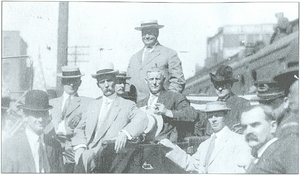
Leroy Kershaw was active in state politics since 1905. He was a delegate to Oklahoma State and Muskogee County meetings. In 1906, he was nominated for the Oklahoma Constitutional Convention. This convention helped create the new state of Oklahoma in 1907.
In 1910, Kershaw hosted U.S. Vice President James S. Sherman in Oklahoma City. Kershaw drove the car during the tour of downtown Oklahoma City. He usually wore a cowboy hat. But for the Vice President, he wore a straw hat like the rest of the welcoming party.
During World War I, Mr. Kershaw was part of the Council of Defense. This group helped prevent price gouging. They also made sure farmers and merchants did not hoard seeds. This protected consumers from high prices and shortages.
From 1924 to 1926, he was the Republican Party chairman for Muskogee County. In 1924, he was a delegate to the Republican National Convention in Cleveland, Ohio. He helped the Puerto Rico delegation get recognized at the convention. This convention nominated Calvin Coolidge for President of the United States.
In 1930, Kershaw ran for Governor of Oklahoma. He decided to withdraw early from the race. He saw that the Democratic candidate, William "Alfalfa Bill" Murray, would easily win. In 1932, Governor Murray appointed Kershaw to a state commission. This commission celebrated the George Washington Bicentennial.
Historic Family Home
In 1943, Leroy Kershaw bought a large home in Muskogee. It was the former home of banker A. W. Patterson. Kershaw lived there with his five children and many grandchildren. The house had five bedrooms upstairs. It also had a large outdoor deck made of stone from Carthage, Missouri. The home had a full basement and a finished attic. Later, an electric elevator was added to connect the first and second floors.
The home was built in 1906, before Oklahoma became a state. It is located at 1320 West Okmulgee in Muskogee. It is one of the city's most important homes. It sits on top of a hill near downtown Muskogee.
The house has a special architectural style called Richardsonian Romanesque. It features stone walls, round arched doorways, and a low-pitched red tile roof. The home was designed by McKibban & McKibban, a firm that designed many early Muskogee buildings. It had four covered porches. The main porch on the east side was very large. It overlooked downtown Muskogee.
The house was home to two important Muskogee businessmen. A. W. Patterson was a co-founder of the Bank of Muskogee in 1901. He was its president until 1918. Kershaw knew Patterson from renting space in his building. Later, Kershaw bought Patterson's home. Patterson was important in making the Arkansas River navigable. He also helped build Muskogee's Convention Hall.
Kershaw lived in the home until he died in 1969 at age 88. The home stayed in the Kershaw family until 1973. In 1984, the home was listed on the National Register of Historic Places.
Images for kids




